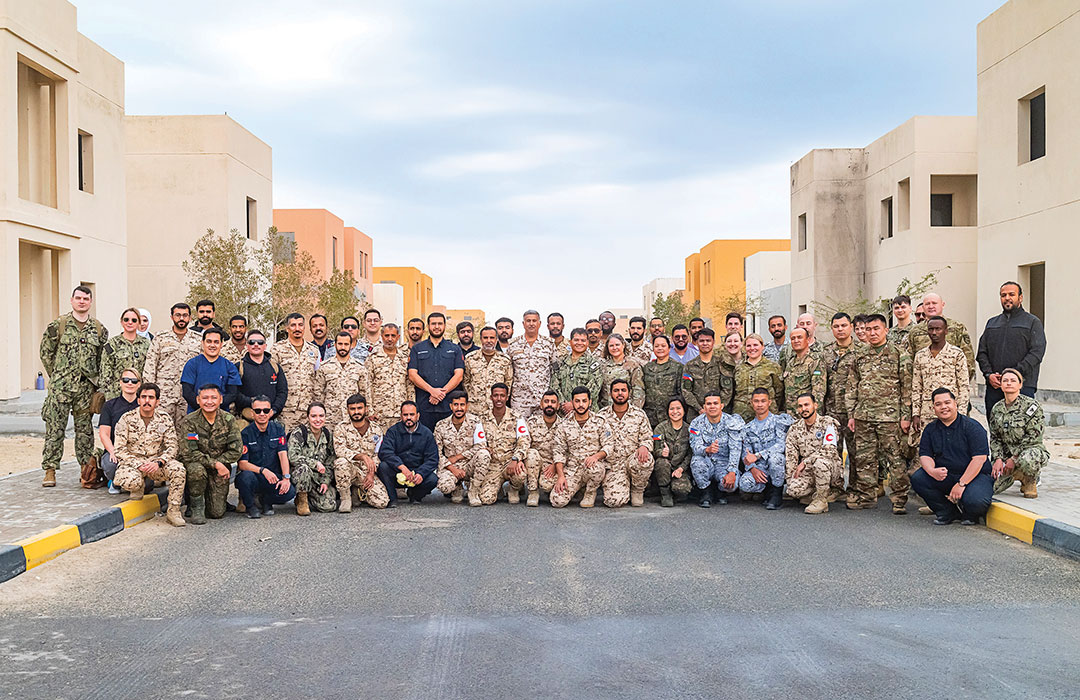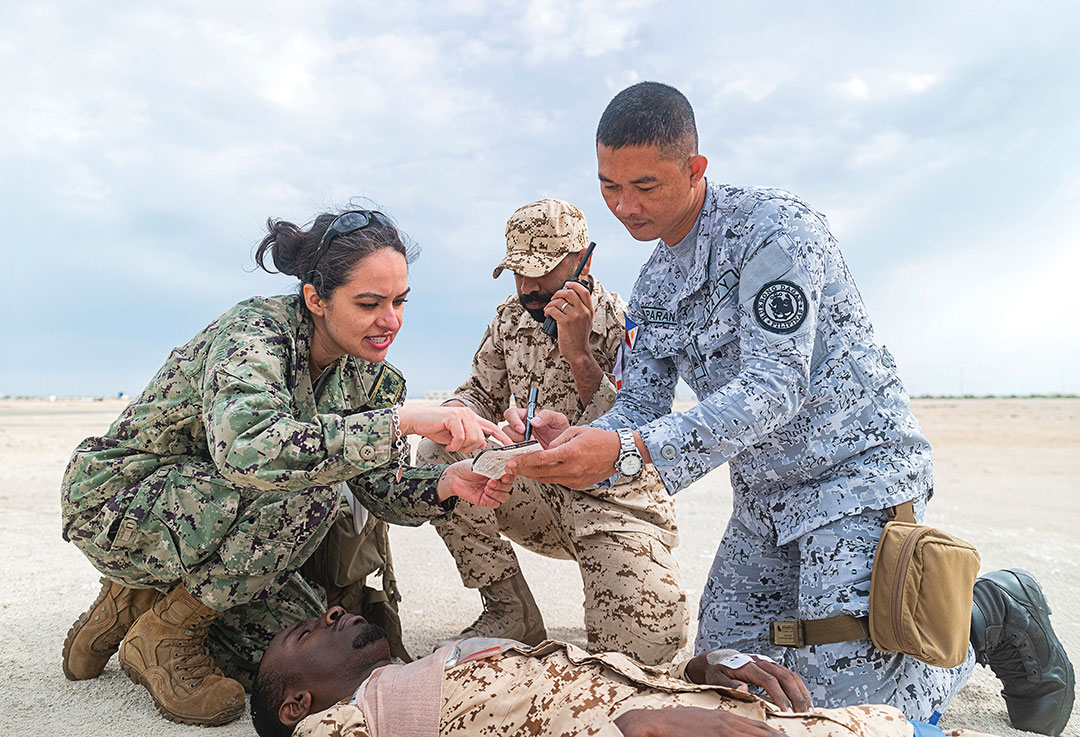A Multinational Medical Mission
Medics, doctors and nurses from eight countries unite to treat battlefield injuries
UNIPATH STAFF | Photos by U.S. Naval Forces Central Command
Every military maintains a dedicated corps of doctors, nurses and medics to prepare for the inevitability of wounds and injuries. But rare is the chance for such troops, based thousands of kilometers apart in their respective home countries,
to share techniques to improve survivability.
Bahrain provided such an opportunity for cooperation and integration by holding a Global Health Engagement for 77 medics, nurses and physicians at the International Maritime Exercise in February 2025.
On a single mission to treat battlefield casualties, Kazakhs and Uzbeks wrapped wounds, set limbs and stanched bleeding beside military colleagues from Bahrain, Jordan, Pakistan, the United States, the Philippines and Australia.
“These sessions help us refresh our medical knowledge to save lives,” said Lt. Cmdr. Asif Ali Jamali, general surgeon from the Pakistan Navy. “It’s important to work with medics and doctors from different navies. Knowing their experience and guidelines and sharing our experience and guidelines for a single, common cause makes us feel more confident and comfortable when we go back to our countries.”

The weeklong global health engagement began with classroom instruction and culminated with a demonstration of skills in the field. Most of the training, complete with demonstrations of the latest in tourniquet technology, occurred at the Crown Prince Center for Training and Medical Research in Bahrain.
Lt. Col. Issa Alnazarova, chief medical surgeon of the Kazakh Naval Forces, praised the teamwork that led to smooth coordination during the mass casualty exercise that capped their training. Multinational teams of medics rescued wounded people — Soldiers and civilians — from a battlefield and transported them to a field hospital.
“Being in a leading position myself, the level of preparedness of the tactical medical teams I observed here impressed me very much,” Lt. Col. Alnazarova said. “It would be ideal if our teams in Kazakhstan were able to perform as well as the teams that demonstrated here.”
The main goal of the medical engagement was to unify medical tactics and procedures among participating countries to save lives more efficiently, said Col. Mohammad Ali Al Buflasah, commander of the Bahrain Defence Forces Royal Medical Services Naval Medical Center.
In line with the main scenario of IMX 2025 — the evacuation of civilians from part of a nation victimized by a missile attack — the medical training focused on rescuing casualties on solid ground instead of previous exercises that focused on treating injuries at sea.
Before the medics conducted their demonstration outdoors, they performed a trial run at an indoor simulation center. A wall-sized monitor generated images and sound effects to mimic a battlefield, complete with explosions, screams and loud gunfire.
Battlefield triage is radically different from regular medical care in civilian hospitals, Col. Mohammad said. In civilian cases, an ambulance equipped with the latest technology transports the injured person on a paved road. As for combat injuries, which can involve gunfire, explosions and amputations, medics often operate in isolation in harsh and dangerous conditions.

“One of the challenges is the difficulty of organizing a medical team consisting of specialists from several countries in treating injuries and evacuating them from the battlefield,” Col. Mohammad said.
“The systems and medicine are the same, but the problem we face is the language. We have countries that speak Russian, Arabic, English and Filipino and African languages. Each country has its own medical terminology and routines that differs from the rest of the countries.”
The main organizer of the IMX medical training was U.S. Navy Lt. Freddie Mawanay, director of Global Health Engagements for U.S. Naval Forces Central Command. The proliferation of armed conflicts and humanitarian crises around the world requires that military medical professionals try to standardize protocols and share innovative technology, he said.
“The toll on human life is staggering, with countless individuals suffering from injuries that could have been mitigated or treated effectively with a coordinated response,” Lt. Mawanay said during a pause in training in Bahrain.
In the name of realism, the Bahraini commander insisted the final training event occur outside in the desert even when the weather forecast predicted rain.

“My American friend asked me if we needed to provide a tent. I said no. We must simulate reality and work in all circumstances,” Col. Mohammad said. “During combat, you do not have a tent, and the battlefield does not allow the doctor to shelter from harsh conditions. The more you expose the team to field conditions, the more you build self-confidence to continue working in all circumstances.”
At least one military visitor to Bahrain agreed with that assessment. For Dr. Qusai Alrashdan, a naval ensign assigned to the Jordanian Royal Medical Services, the field training felt as realistic as possible.
“We faced challenges similar to what we might face in the field of operations,” Dr. Qusai said. “That helped us enhance our readiness to respond to medical emergencies in a combat environment.”


Comments are closed.